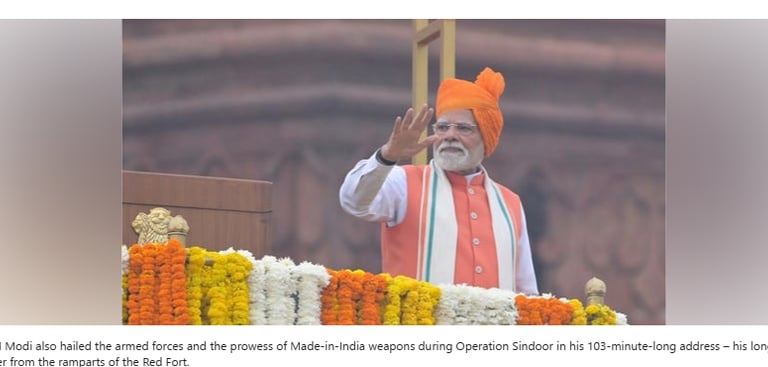PM Modi Independence Day 2025 Speech | Atmanirbhar Bharat & Viksit Bharat Vision
PM Modi’s 2025 Independence Day speech outlines Atmanirbhar Bharat, Mission Sudarshan Chakra, GST reforms, and a roadmap for Viksit Bharat 2047.
PM MODI UPDATES


New Delhi, August 15, 2025 — On the 79th Independence Day of India, Prime Minister Narendra Modi delivered his longest-ever Red Fort address, outlining a detailed vision for India’s development over the next two decades. In a speech lasting 103 minutes, the PM emphasised Atmanirbhar Bharat (self-reliance) as the foundation of Viksit Bharat (Developed India) and announced sweeping reforms in defence, economy, energy, and technology.
From Mission Sudarshan Chakra in defence to India’s first indigenous semiconductor chip, PM Modi’s announcements are aimed at strengthening national security, boosting economic growth, and positioning India as a global leader by its centenary of independence in 2047.
Atmanirbhar Bharat: The Heart of the 2047 Vision
PM Modi’s central message was clear: self-reliance equals self-respect. He warned that over-dependence on foreign powers can threaten freedom itself, urging Indians to strengthen domestic capabilities in every sector.
“The more a country is dependent on others, the bigger the question mark on its independence.”
Key points under Atmanirbhar Bharat:
Self-reliance in defence – indigenous jet engines, advanced missile systems, and homegrown weaponry.
Economic independence – reforms in taxation, manufacturing, and trade.
Technological sovereignty – development of chips, critical minerals, and next-gen R&D.
Energy self-sufficiency – solar, nuclear, hydrogen, and EV battery production.
Defence and National Security Announcements
The defence sector took centre stage in the PM’s speech, with national security framed as the backbone of economic prosperity.
1. Mission Sudarshan Chakra
A homegrown anti-ballistic missile defence system, inspired by Lord Krishna’s legendary weapon.
Designed to counter terrorist attacks and neutralise enemy missiles with high precision.
Entirely researched, developed, and manufactured in India.
Will enhance both defensive and offensive capabilities.
2. Operation Sindoor & Indigenous Weapons
Highlighted the success of Operation Sindoor, where Made-in-India weapons stunned enemies.
Stressed that without Atmanirbhar Bharat, such military success would not have been possible.
Called for indigenous jet engine manufacturing to replace reliance on GE engines for Tejas fighter jets.
3. High-Powered Demography Mission
Designed to tackle illegal infiltration and protect border state demographics.
Addresses the employment threat posed by undocumented immigrants.
Declared infiltration a “well thought-out conspiracy”.
Economic & Tax Reforms for Viksit Bharat
PM Modi outlined major economic reforms aimed at making India more competitive and inclusive.
Next-Generation GST Reforms
Launching on Diwali 2025, these reforms will:
Reduce tax rates on essential goods.
Provide relief to MSMEs, local vendors, and consumers.
Simplify compliance for businesses.
Streamline the tax structure for ease of doing business.
PM Viksit Bharat Rozgar Yojana
Employment scheme targeting 30 million young Indians.
Focused on job creation in growth sectors like technology, infrastructure, and renewable energy.
Reform Task Force
A dedicated policy reform team to implement next-generation structural changes.
Will work with states to simplify governance and regulations.
Technology & Innovation Push
India’s technology ambitions were strongly featured, with the PM declaring 2025 a breakthrough year for innovation.
First Made-in-India Semiconductor Chip
To be launched by end of 2025.
Marks India’s entry into global semiconductor manufacturing.
Critical for electronics, EVs, and defence systems.
Critical Minerals Independence
Focus on lithium, cobalt, rare earths, and graphite.
Essential for electronics, renewable energy, and electric vehicles.
Reducing dependence on foreign supply chains.
Indigenous Jet Engines
PM urged scientists and engineers to develop jet engines for Indian fighter jets.
Goal: Eliminate reliance on foreign engine suppliers.
Energy Independence & Sustainability
PM Modi’s speech included a clear roadmap to achieve energy security.
Nuclear Energy Expansion
10 new nuclear reactors planned.
Goal: Increase nuclear capacity 10-fold in 20 years.
Part of a balanced renewable energy portfolio.
Green Energy Projects
Boost to solar, hydrogen, and hydropower.
EV battery production to be scaled domestically.
Fertiliser manufacturing to be made Atmanirbhar.
National Deepwater Exploration Mission
Will tap into ocean resources to fuel the blue economy.
Farmers, Fishermen & Rural Development
The PM reassured farmers, fishermen, and cattle rearers of his unwavering support:
“I will stand like a wall against any policy that harms their interests.”
Agriculture contributes 18% to India’s GDP and employs millions.
No compromise on agricultural protections despite global trade pressures.
Global Context: Economic Self-Defence
Without naming specific leaders, PM Modi indirectly referenced global trade wars:
Stressed the need to enhance domestic capabilities.
Warned against being trapped by economic selfishness of other nations.
Positioned India as a bright spot amid global uncertainty.
Inspirational Quotes from PM Modi’s Speech
“The greatest criterion for self-dignity is self-reliance.”
“Without Atmanirbhar Bharat, Operation Sindoor’s success wouldn’t have been possible.”
“Swadeshi should not come from desperation, but from strength.”
“No selfishness will be able to entangle us if we enhance our capabilities.”
Conclusion: India’s March to 2047
PM Modi’s Independence Day 2025 address was not just a speech—it was a 20-year strategic plan.
With self-reliance as its foundation, India’s vision for Viksit Bharat focuses on:
National security through indigenous defence systems.
Economic strength via reforms and manufacturing.
Technological leadership in semiconductors and critical minerals.
Energy independence using renewable and nuclear power.
The roadmap is ambitious, but the PM’s message was clear: India’s future depends on India’s own capabilities. By 2047, the goal is a secure, prosperous, and globally respected India.
